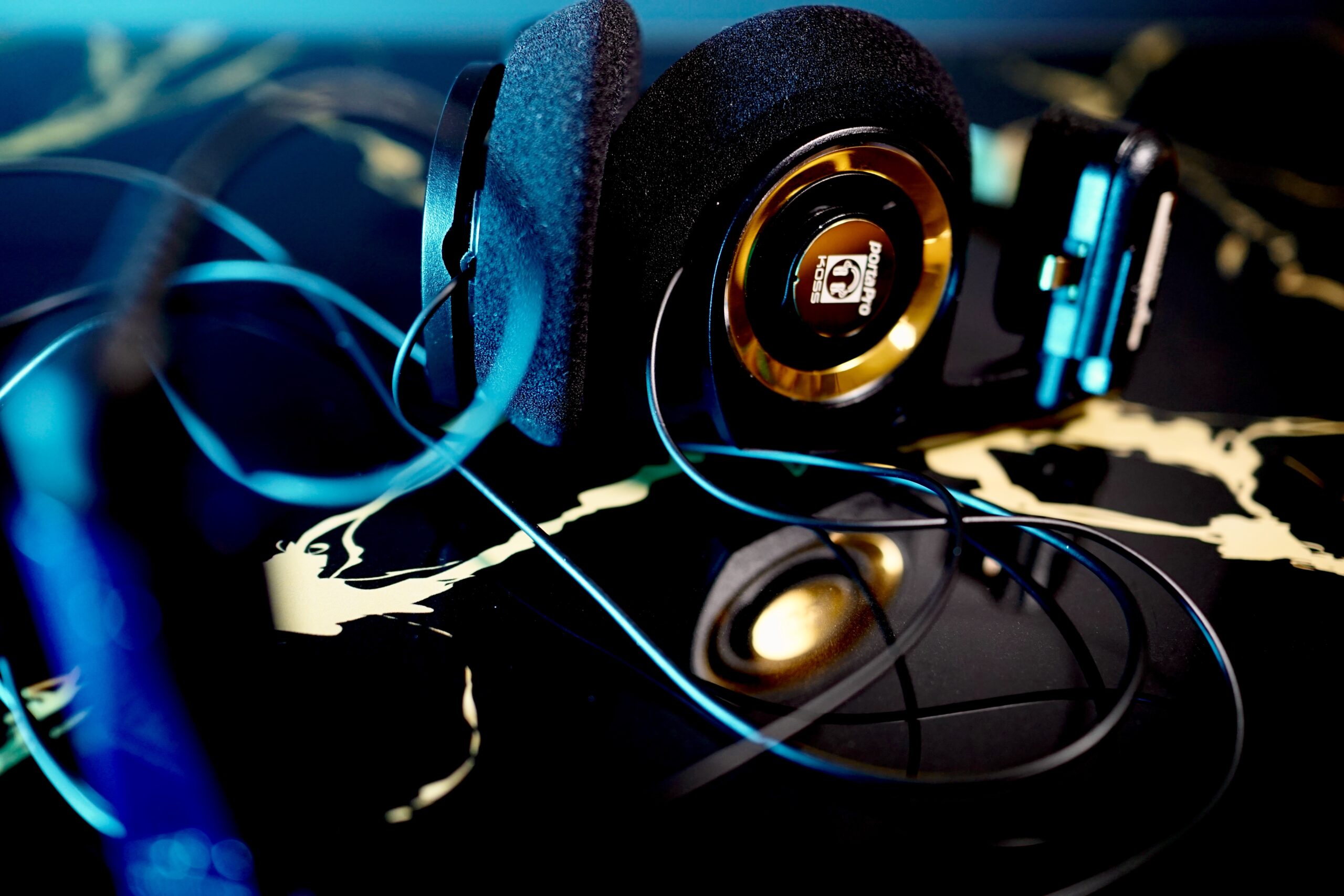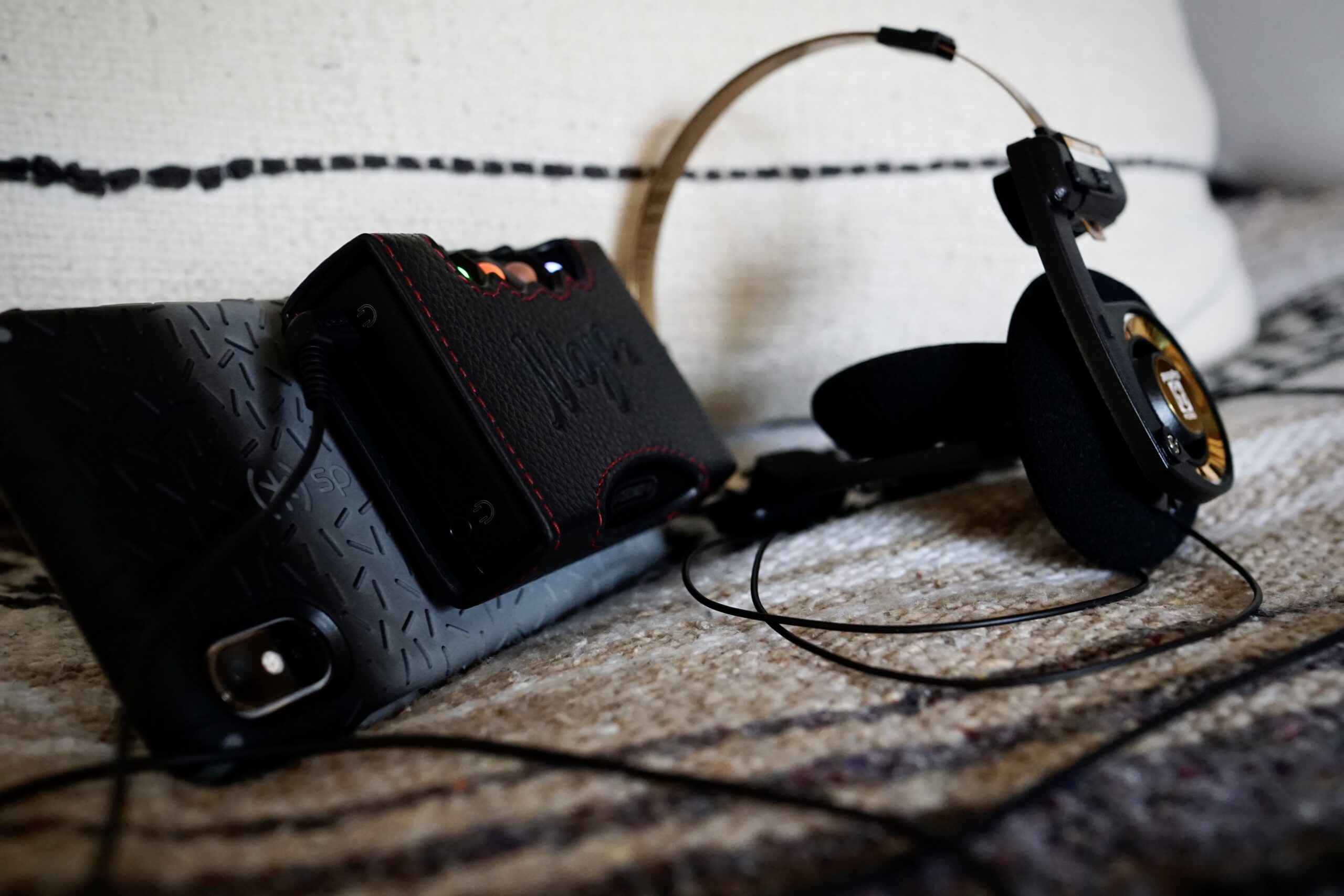The Mojo2 is a revision of Chord Electronics popular DAC/headphone amplifier, the Chord Mojo which was released in 2015.
The Mojo2 brings several updates that include Cross Feed, Intelligent Desktop Mode, and DSP Equalization that Chord touts as lossless. The headphone amplifier has also received a slight increase in power output. Now let’s see if it’s worth the upgrade.
Build
The build quality and design is typical Chord, which is a robust aluminum chassis that’s controlled by four buttons; Power, Volume Up, Volume Down, and the addition of a new Menu button. The Mojo2 omits a display and instead uses color-coded lights to indicate when the device is powered on, charging status, volume level, bit-rate, and the varying controls of the newly added feature accessed through the Menu button.
An optional black leather case is available that has a nice pebbled texture, with contrasting red stitching.
Specs
The Mojo2 uses a digital converter that’s built on an FPGA (Field Programmable Gate Array) chip using a custom WTA (Watts Time Alignment) filter designed by Rob Watts.
The Mojo 2 is capable of playing music files up to PCM 768 kHz 32- bit and DSD 256. Power output of 600 mW @30 Ohms or 90 mW @ 300 Ohms is available, with a Dynamic Range of 125 dB, and THD of 0.0003% @2.5 V/300 Ohms.
Digital inputs include USB-Micro, 3.5mm COAXIAL, TOSLINK, and the addition of USB-C. Charging is relegated to Micro USB.
A link to a paper written by Keith Howard describing Watts’ filter/converter tech and principles can be found here:
https://drive.google.com/file/d/1QhJo_Rh8sQsItFvJ1g-MnNlg9pBR6oja/view?usp=sharing
In Use
There’s definitely a learning curve with Chord’s light scheme, but once you get the colors/ functions down things are fairly smooth and practical. Who doesn’t enjoy colored lights?
Having previously owned the Mojo I was familiar with its performance and had a general expectation of how the new Mojo would fair.
Power it up, connect to source, and start enjoying your music.
The Mojo2 has a few more options that can be useful, but for my use I’ll run it ‘stock’ 90% of the time. More on the new features later.
Sound
Powering up the unit kicks off a series of lights that takes about seventeen seconds before the Mojo2 is ready. I’m using an iPhone XS Max running Apple Music Lossless as my source connected via Lightning to USB-C. I’ve paired the Mojo2 with multiple headphone that have included Koss Porta Pro (my kick around headphones), Lawton-Modded Fostex TH-610, Focal Clear MG, and for testing purposes, HifiMan HE6se.
Starting off my listening via the Porta Pros (a value at a mere $30-40 including the addition of Yaxi Pads) I became immediately aware that there were improvements. The Mojo was a fun, forward, sort of v-shaped voicing that produced a fast, holographic sound. Chord DACs are designed with transients and time domain first and foremost, and I think Rob Watts has mostly succeeded in his endeavors.
What initially stood out from my first listen was the tightened speed of things. Leading edges of notes seemed to strike with greater immediacy. The more I listened, the more I could hear that the soundstage seemed to shape things with greater clarity and precision. While still having a more spherical presentation, where things were presented seemed more defined and accurate. The blackness between those images had also improved.
When moving up to more resolving headphones such as the Fostex with their larger staging made these qualities more easily observable. The Focal’s step things up even further in terms of their technical prowess and more accurate imaging.
With songs such The Acid’s Fame, a synthesized beat pans not left to right, but in a clockwise, ovoid around the listener while a guitar melody later kicks in bouncing from right and left. Lending to a better sense of the space within the song. I love this album with its layering of sounds and Ry Cuming’s ethereal vocals. It’s a fun listen off of the Mojo2.
It’s not a large stage, it’s actually somewhat intimate as it presents detail in a slightly forward fashion, but things maintain an appropriate level of separation, and depth appropriate to the recording.
Bass was less elevated, but again tightened up, and more textured. It extends just as low, but with less of an elevation. My understanding is that Chord removed a servo (or some part I’m misidentifying) from the amplifier that caused some distortion that affected bass. Whatever they did was an improvement. Bass is better defined and more neutral to the recording. It’s also presented with excellent impact that I much prefer over an elevation. Quality trumps quantity for me, and the Mojo2 provides it.
Mids are where the Mojo2’s forwardness becomes more apparent. It’s not fatiguing, but the range is definitely pushed forward, combined with the speed and smaller stage it presents details on an audio platter. Vocals are appropriate to the recordings and simultaneously always present, though never coming across as shouty (I tend to be sensitive to peaks, especially in the upper mids/lower treble).
Details such as Thom Yorke’s fingers rubbing on the strings, and the fleshy sound of his thudding as he drums against his guitar are presented with great clarity and realism on Radiohead’s Give Up the Ghost. It is a fantastically haunting song with its simple melody and the Mojo2 conveys those emotions beautifully. Thom and Johnny are a brilliant duo (check out the live rendition on Live From the Basement. It’s awesome).
Timbre is also well demonstrated with this song as there’s a sense of realism to everything. Weather it be Thom’s voice, or the two guitars being played, it just sounds right.
Mr. Watts’ tweaking of his software is paying off (more thoughts on this to follow).
Highs are present as all of the other frequencies and improved from the previous Mojo as they seem to be less smoothed/rounded. I don’t mean that they were rolled off before, or now are more elevated than the previous Mojo, but that the filtering employed seems to have an overall smoothness to sounds. A sort of smoothing of edges, not a reduction in quantity or level. The smoothing effect is what has been reduced, to my ears. Allowing for a more natural sound, imo. Highs have a similar forwardness as the mids, but remain controlled and never seem to come off as bright or sibilant. Cymbal crashes have the proper amount of sizzle, and bells such as in the next track I’ll be citing sound realistic to my ears.
My guess is that it’s related to how Watts tackles transients and time domain issues, but with the updated software it’s less apparent. It seems tighter, and faster which adds a sense of crispness to the sound that’s welcomed by me.
There was enough of a difference that I connected the Mojo2 to Linear Tube Audio’s MZ3 to compare it to the Chord Qutest.
By Comparison differences are noticeable. The Mojo2 sounds faster, and more defined than the Qutest. The Mojo2 also presents details in a more forward fashion that was a little fatiguing for me paired with the LTA as I find the MZ3 to be extremely fast and resolving. The synergy wasn’t there for me, and I definitely prefer the Qutest’s more laidback approach and presentation of details in comparison (though the Qutest isn’t quite laidback compared to many DACs in the price range). They’re present, just not pushed as forwarded compared to the Mojo2.
If Rob Watts applied the same ‘tweaks’ affecting speed of transients to the Qutest’s software, that would be something I’d really like to hear.
The software changes seemed to have removed some of the smoothing effect that many associate with Chord’s DACs, as previously mentioned (a common criticism of their sound). It’s a step in the right direction, and it sounds really good on their entry level Mojo2.
The speed, accuracy, and immediacy with which sounds are reproduced are very impressive and add to a sense of realism. On Felix Laband’s Dirty Nightgown the pinging of a bell from left to right, and both beside and forward of the listener are done without flaw. There’s the initial strike, plus the harmonic decay of the bells occurring all around and the Mojo2 never stutters placing sounds precisely where they should be. The bells are followed and layered by a tapping that produces a very cool effect (check it out if you haven’t heard it).
For fun I tried the HifiMan HE6se, a very inefficient and power hungry headphone (think Susvara, similar specs). As expected the Mojo2 couldn’t appropriately drive them, but it wasn’t terrible, it just wasn’t optimal. Things were much too lean as there wasn’t adequate power for the hungry HifiMan. Timbre and presentation were fine, but it’s definitely not an optimal pairing.
Additional Features such as cross feed are implemented well. It sounds identical to the cross feed used on the Hugo TT2. It’s effective and can be fun but I prefer it without the cross feed. To my ears the soundstage width shrinks in a bit, though depth might have increased tad.
The Lossless EQ is also a nice addition, but I don’t ever use it. I tend to use headphones that I like, though they may not be perfect I don’t ever find the urge to EQ. It works though it’s more of a wider shelf than precise frequencies like a Low, Mid, High adjustment.
Desktop Mode is nice in that it has smart charging circuitry built in to preserve battery life, making the Mojo2 an even more compelling alternative as a transportable solution. If one wanted to use their HE6se at work, they could simply connect an appropriate amp using the Mojo2 as a DAC while still being able to take the Mojo2 out for lunch with some IEM’s. A nightstand setup would probably be another example of this.
Conclusion
I received the Mojo2 as a birthday present and it’s one of the most enjoyable gifts that ever I’ve received. It’s a fun, dynamic portable that has greater speed than my desktop Qutest, has excellent resolution of micro details, and a very holographic sound with some of the best transients found on any portable I imagine.
Yes it’s better than the previous Mojo and the sonic improvements are reason enough to justify the increase in cost. It’s not as picky with headphone pairings either, which is another bonus. All of the reasonable headphones I paired sounded fine to my ears, and there are few that I look forward to trying in the future. The Meze Elite being a n example as they sounded fantastic with the first gen Mojo.
It’s a fine portable DAC that I can confidently recommend for its impressive immediacy and realism of sound. The added features are icing on the Chord cake.
Cheers

Just a guy that Loves music.
